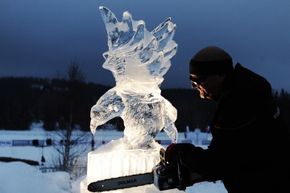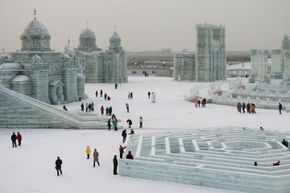Talented sculptors hone their skills over decades to express their artistic intent in the most powerful way they can imagine. Some of these artists inspire such awe that their stone work becomes famous for hundreds of years. Others are famous for about four to six hours. That's the burden faced by ice sculptors.
Ice sculptures can take nearly any form, from massive dragons, to medieval warriors, to tigers, to bears. These works used to be a rare extravagance. Now, they're an increasingly commoditized product, particularly in their smaller forms.
Advertisement
The most common ice sculptures are small- to medium-size pieces commissioned for fancy weddings and corporate events at a cost of $300 and up. For example, you might see an elegant ice swan as a centerpiece for chilled appetizers or drinks. At press and investor events, companies like to show off their success and profits by ordering sculptures emblazoned with their corporate logos (while ostensibly ignoring the ominous symbolism of melting and dripping that always follows). Many of these pieces are machine made.
Human ice carvers take their work to bigger proportions and they don't just work as vendors. These sculptors have creative vision and technical skills that are necessary for working with a material that features radically different properties depending on environmental conditions and even on the type of water that's used to make the ice. That means they have to know their science, too.
Their final results aren't merely neatly-stacked blocks of snow. These works of art may range from simple shapes (like rectangles or circles) to full-blown figures of people and animals, complete with exquisite and perilously delicate details like individual fingers and feathers. At room temperature, these piece may last for a few hours. In the middle of a frozen winter landscape they could last for months.
Sculptures may come from a single block of ice or they may be built from numerous blocks of ice melted together. No matter how big or how small, they're going to be heavy. A gallon of water weighs roughly 8 pounds (3.6 kilograms); in frozen form the weight doesn't change much. Stack a few frozen blocks of ice together and you'll see that a sculpture gets scary-heavy in a hurry, yet another technical challenge that artists must consider.
Ice sculpting is an ephemeral type of art. These crystalline pieces feature many of the technical intricacies and symbolism of traditional sculptures. And sometimes they are simply functional and fun. How exactly do clever artists transform ice into art?
Advertisement




